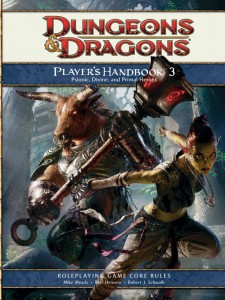 With the release of the PHB3 we have four new player character races to add to our available choices. Today I want to consider the Shardmind, beings of raw psionic energy barely contained in a body of gleaming crystalline shards.The Shardmind is built for the purpose of supporting the new psionic power source classes. Of course the Shardmind is also capable of doing much more than this as the player can select how they’d like their ability scores distributed. I’m of mixed minds about the Shardmind, part of me wants to love this race, another part isn’t too sure.
With the release of the PHB3 we have four new player character races to add to our available choices. Today I want to consider the Shardmind, beings of raw psionic energy barely contained in a body of gleaming crystalline shards.The Shardmind is built for the purpose of supporting the new psionic power source classes. Of course the Shardmind is also capable of doing much more than this as the player can select how they’d like their ability scores distributed. I’m of mixed minds about the Shardmind, part of me wants to love this race, another part isn’t too sure.
Tag: Shardmind
Psionics. I’ll admit that over the years I’ve never been a huge fan of psionics in D&D. I cringed when Wizards announced that PHB3 would introduce psionic powered character classes to 4e D&D. My initial (and completely uninformed) opinion on the matter was that psionics suck. However, over the past few months as preview material was released through DDI, I got a chance to see some of these new psionic classes first hand. I’ll admit that the preview content started bringing me around on psionics. Now that I’ve actually got a PHB3 with the full builds for each of the new psionic classes I find myself completely turned around on psionics.
In our Player’s Handbook 3 Review (Part 1) we covered the new races and the new divine leader class, the Runepriest. In Player’s Handbook 3 Review (Part 2) we covered skill powers, feats and new magic items. In today’s article we’ll look at psionics.
In our Player’s Handbook 3 Review (Part 1) we looked at the new Shardmind race and one of the new classes, the Runepriest. Today in our PHB3 Review (Part 2) we’re looking at skill powers, feats, superior implements and new magic items. In our PHB3 Review (Part 3) we’ll delve into a detailed look at the psionic classes.
 Here’s a quick recap of the new races and classes available in the PHB3.
Here’s a quick recap of the new races and classes available in the PHB3.
New Races
- Githzerai
- Minotaur
- Shardmind
- Wilden
New Classes
- Ardent (psionic, leader)
- Battlemind (psionic, defender)
- Monk (psionic, striker)
- Psion (psionic, controller)
- Runepriest (divine, leader)
- Seeker (primal, controller)
There are also complete rules for building Hybrid characters of all classes (including all six new classes introduced in the PHB3).
 You may think that you know what the Player’s Handbook 3 is all about if you’ve got a DDI subscription, but the preview content was just the tip of the iceberg. If you’re a DDI subscribers who’s considering passing on the PHB3, think again. This is one of the coolest 4e D&D books that’s come out so far.
You may think that you know what the Player’s Handbook 3 is all about if you’ve got a DDI subscription, but the preview content was just the tip of the iceberg. If you’re a DDI subscribers who’s considering passing on the PHB3, think again. This is one of the coolest 4e D&D books that’s come out so far.
The PHB3 comes out next week on Tuesday, March 16, but for those of us living in the Greater Toronto Area it came out this past Friday. I visited three gaming stores and a major book selling chain and they all had it proudly displayed for sale. I don’t know if this complete disregard for the street date is limited to my area or if this is the case across the board. All I know is that I was fortunate enough to get my copy of the PHB3 Friday and I haven’t put it down since.
I took some flack for my Martial Power 2 review last month. Some readers didn’t think I spent enough time giving my opinion. With my review of the PHB3 I’m going to listen to the readers and do more than just tell you what’s in the book. But given the amount of material in the PHB3 it’s going to take more than one article to cover everything. So as seems fitting, I’m going to break my review of the PHB 3 into three parts. Today we’ll look at the new races and one of the new classes – the Runepriest.